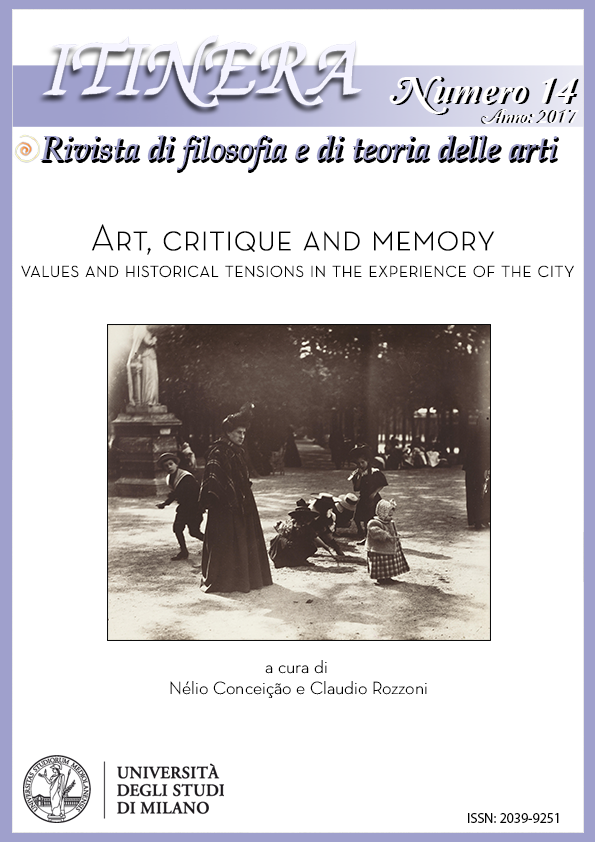Il Castello di Barbablù di Béla Bartók. Un’ipotesi di lettura
DOI:
https://doi.org/10.13130/2039-9251/9512Abstract
Bluebeard’s Castle (A kékszakállú herceg vára), composed by Béla Bartók on a libretto by Béla Balázs, is one of the most significant musical works of the early twentieth century and a masterpiece of Hungarian modernism. The opera deals with “the eternal tragedy of the dualism between man and woman” from an original point of view, divergent from the widespread one in Western European thought and art. The essay investigates Bartók’s musical dramaturgy according to this topic.
Riferimenti bibliografici
ANTOKOLETZ, Elliot, The Music of Béla Bartók. A Study on Tonality and Progression in Twentieth-Century Music, University of California Press, Berkeley-Los Angeles-London 1984.
--, Musical Symbolism in the Operas of Debussy and Bartók. Trauma, Gender and the Unfolding of the Unconscius, Oxford University Press, Oxford-New York 2004.
--, “Bálazs Béla: Napló”, Bécsi Magyar Újság, 21 maggio 1922.
BÁLAZS, Béla, “Maeterlinck”, Nyugat, I/1, 1908, pp. 446-454.
––, “A tragédianák metafizikus teóriája a német romantikában és Hebbel Frigyes”, Nyugat, I/2, 1911.
––, A vándor énekel, Nyugat Irodalmi és Nyomdai Részvénytársaság, Budapest 1911.
––, Misztériumok, Nyugat Irodalmi és Nyomdai Részvénytársaság, Budapest 1912.
––, Der Sichtbare Mensch oder die Kultur des Films, Deutsch-Österreichischer Verlag, Wien-Leipzig 1924; tr. it. L’uomo visibile, a cura di L. Quaresima, Lindau, Torino 2008.
––, “A Kékszakállú herceg vára: Megjegyzések a szöveghez”, in Bálazs Béla: Válogatott cikkek és tanulmdnyok, a cura di M. Nagy, Kossuth Könyvkiadó, Budapest 1968.
Béla Bartók Essays, a cura di B. Suchoff, Faber & Faber, London 1976.
BARTÓK, Béla, Scritti sulla musica popolare, popolare, a cura di D. Carpitella, Boringhieri, Torino 1955.
––, Lettere scelte, a cura di J. Demény, Il Saggiatore, Milano 1969.
BOSSARD, Eugène, Gilles de Rais maréchal de France dit Barbe-Bleue (1404-1440), Champion, Paris 1886.
CADARS, Pierre, “Sept compositeurs pour une Barbe-bleue”, L’Avant Scène Opéra, 149-150, 1992.
CARPITELLA, Diego, “Introduzione”, in B. Bartók, Scritti sulla musica popolare, a cura di D. Carpitella, Boringhieri, Torino 1955, pp. 3-31.
ESTÉS, Clarissa P., Donne che corrono con i lupi, Frassinelli, Como 1996.
FERRERO, Ernesto, Barbablù. Gilles de Rais e il tramonto del Medioevo, Einaudi, Torino 2004.
FLAUBERT, Gustave, Salammbô, a cura di L. Binni, Giunti, Firenze 2005.
FRANCE, Anatole, Les Sept Femmes de la Barbe-Bleue et autres contes merveilleux, Calmann-Levy, Paris 1910; tr. it. Le sette mogli di Barbablù e altri racconti meravigliosi Donzelli, Roma 2004.
FRIGYESI, Judit, Béla Bartók and Turn-of-the-Century Budapest, University of California Press, Berkeley-Los Angeles 1998.
GIRARDI, Michele, “Un viaggio all’interno della coscienza. Pensieri sul Kékszakállú Herceg Vára”, in Il castello del Principe Barbablù, Venezia, Teatro La Fenice, Stagione lirica 1995, programma di sala, pp. 77-97.
GRAZIOLI, Cristina, Luce e ombra, Storia, teorie e pratiche dell’illuminazione teatrale, Laterza, Bari 2008.
GRIMM, Jacob Ludwig Karl, GRIMM, Wilhelm Karl, Kinder- und Haus-Märchen, 2 voll. Realschulbuchhandlung, Berlin 1812-1815.
HEBBEL, Friedrich, Judith. Eine Tragódie in Funf Akten, Hans von Weber Verlag, Münich 1908.
HERMANSSON, Casie, Bluebeard. A Reader’s Guide to English Tradition, University Press of Mississipi, 2009.
HONTI, Rita, Principles of Pitch Organization in Bartók’s Duke Bluebeard’s Castle («Studia musicologica Universitatis Helsingiensis XIII), University of Helsinki, Helsinki 2006.
Dowloads
Pubblicato
Fascicolo
Sezione
Licenza
Gli autori che pubblicano su questa rivista accettano le seguenti condizioni:
1. Gli autori mantengono i diritti sulla loro opera e cedono alla rivista il diritto di prima pubblicazione dell'opera, contemporaneamente licenziata sotto una Licenza Creative Commons - Attribuzione - Condividi allo stesso modo 4.0 internazionale che permette ad altri di condividere l'opera indicando la paternità intellettuale e la prima pubblicazione su questa rivista.
2. Gli autori possono aderire ad altri accordi di licenza non esclusiva per la distribuzione della versione dell'opera pubblicata (es. depositarla in un archivio istituzionale o pubblicarla in una monografia), a patto di indicare che la prima pubblicazione è avvenuta su questa rivista.
3. Gli autori possono diffondere la loro opera online (es. in repository istituzionali o nel loro sito web) prima e durante il processo di submission, poiché può portare a scambi produttivi e aumentare le citazioni dell'opera pubblicata (Vedi The Effect of Open Access).





